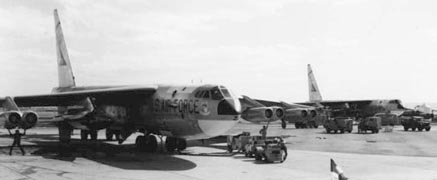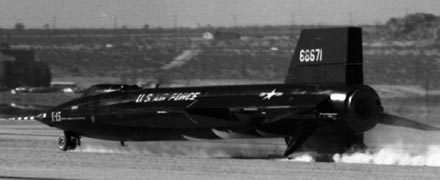 Attempt to launch two X-15s in a
single day, Captain Robert Rushworth's First X-15 Flight, November 4
Attempt to launch two X-15s in a
single day, Captain Robert Rushworth's First X-15 Flight, November 4Forty Years ago in the X-15 Flight Test Program, November 1960 |
 Attempt to launch two X-15s in a
single day, Captain Robert Rushworth's First X-15 Flight, November 4
Attempt to launch two X-15s in a
single day, Captain Robert Rushworth's First X-15 Flight, November 4Another attempt to launch the first flight of the X-15-2 with the XLR-99 engine was scheduled for November 2, 1960, but it was cancelled by weather.
On November 3, 1960, the X-15-1 was mated to the NB-52B and the X-15-2 was mated to the NB-52A in an attempt to launch both of them on the same day. Bad weather set in and cancelled the attempt for that day.
 On November 4, Scott Crossfield
entered the cockpit of the X-15-2 to make another attempt at the
first flight of the XLR-99 rocket engine. Captain Bob Rushworth
got into the X-15-1 to make his first X-15 familiarization
flight. After the NB-52A had taken off, the X-15-2 developed a
hydraulic leak and Crossfield's flight was aborted. Major Fulton
and Major Cole successfully launched Captain Rushworth from the
NB-52B on mission 1-16-29. On his first X-15 flight, Rushworth
reached mach 1.95 (1,287 miles per hour) and an altitude of
48,900 feet. Photo E-6186 Courtesy NASA Dryden.
On November 4, Scott Crossfield
entered the cockpit of the X-15-2 to make another attempt at the
first flight of the XLR-99 rocket engine. Captain Bob Rushworth
got into the X-15-1 to make his first X-15 familiarization
flight. After the NB-52A had taken off, the X-15-2 developed a
hydraulic leak and Crossfield's flight was aborted. Major Fulton
and Major Cole successfully launched Captain Rushworth from the
NB-52B on mission 1-16-29. On his first X-15 flight, Rushworth
reached mach 1.95 (1,287 miles per hour) and an altitude of
48,900 feet. Photo E-6186 Courtesy NASA Dryden.
The first flight of the big engine was postponed again on November 5 because of weather and again on November 7 because the lakebed was wet from the recent rains.
Major Allavie and Captain Kuyk finally launched Crossfield in the X-15-2 from the NB-52A over Rosamond Dry Lake on November 15, 1960. Mission 2-10-21, the first XLR-99 powered flight, went faster and higher than planned. At 50% thrust, the big engine pushed the X-15-2 to Mach 2.97 (1,960 miles per hour) rather than the intended Mach 2.7 and 81,200 feet high, over 20,000 feet higher than the planned 60,000 feet.
Although Crossfield was restricted to speeds below Mach 3 during the contractor demonstration flights, a measurement error of only one part in one thousand would put his speed on this flight right at Mach 3. It cannot be stated with certainty that he did not exceed Mach 3 on that flight. Without doubt, he saw the Mach meter needle pointing directly at the three during the flight.
 The X-15-2 lands after a flight with XLR-99
engine. It still has the barber pole air data sensor boom on its
nose, so it is at the end of a flight flown on November 15, November 22, or
December 6, 1960. Photo courtesy: AFFTC/HO.
The X-15-2 lands after a flight with XLR-99
engine. It still has the barber pole air data sensor boom on its
nose, so it is at the end of a flight flown on November 15, November 22, or
December 6, 1960. Photo courtesy: AFFTC/HO.
Captain Rushworth was launched on his second flight in the X-15-1 from the NB-52A by Major Fitzhugh Fulton and Major Jack Allavie over the town of Palmdale on November 17. The lower XLR-11 engine shut down prematurely, but Rushworth was able to restart the engine and complete the flight as programmed. He reached a top speed of Mach 1.9 (1,254 miles per hour) and a maximum altitude of 54,750 feet.
Crossfield made the second flight of the X-15-2 with the XLR-99 engine on November 22. He was launched from the NB-52A by Fulton and Allavie over Rosamond Dry Lake. The prime objective of the flight was to test the operation of the big engine. Crossfield throttled it down to 75% power and then down to 50% power. He shut down the engine and restarted it. Again he exceeded his programmed speed by two tenths of a Mach number.
Neil Armstrong made his first flight in the X-15-1 on November 30. Frank Cole piloted the NB-52B and Major Fulton occupied the right seat as they dropped Armstrong over Palmdale. One of the rocket chambers of the XLR-11 engines shut down. He completed the flight on seven cylinders. On his introductory flight his top speed was just Mach 1.75 (1,155 miles per hour) and the highest altitude was only 48,840 feet.
 Books about
the X-15 available from
Books about
the X-15 available from 
 Angle of Attack : Harrison Storms and the Race to
the Moon by Mike Gray. The biography of Harrison Storms, who
was instrumental in the development and operation of the X-15.
Angle of Attack : Harrison Storms and the Race to
the Moon by Mike Gray. The biography of Harrison Storms, who
was instrumental in the development and operation of the X-15.
 At the Edge of Space : The X-15 Flight Program
by Milton O. Thompson. The story of test flying the X-15 from the
point of view of the pilot.
At the Edge of Space : The X-15 Flight Program
by Milton O. Thompson. The story of test flying the X-15 from the
point of view of the pilot.
*The first position of the mission number identifies which X-15 was involved, the second number indicates how many times that X-15 had been launched, and the third number indicates how many times it had been carried by an NB-52.
Send a message to Brian
Go to home page of the Goleta Air & Space Museum.
Edited November 15, 2000.